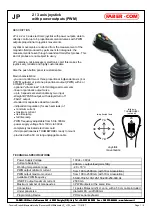
L-VIS User Manual
143
LOYTEC
Version 6.2
LOYTEC electronics GmbH
playback started, or the connection attempt resulted in an error which is shown in the
control. This will ensure that the output data points will accurately reflect what the user
currently sees on the display.
NOTE:
Using run time control is optional. If there is only one camera configured, it may be set as
the default camera to play when the control is visible. In this case, no data points need to
be connected, as the control will start playback of the video stream automatically. The
same is true for a control with multiple cameras, when the default playback is set to auto-
cycle. However, an output data point may be desired in this case.
9.6 Data Point
Data point objects control the data transfer between a register or a network value and the
controls or other data processing objects on the device. To archive this data transfer, there
are tree objects involved:
The
control
element, which acts as the interface to the user, or any other object
which processes data, like mathematical objects, alarm generators, triggers, or
action objects.
A
data point object
which is connected to the control and references a specific
data point, thereby linking the control to a data source and/or sink. It also defines
the properties of this data link, for example when new data is to be transferred
between the data point and the control, and how the data should be converted
when it is transferred.
A
data point
as the source or sink of data, for example an internal user register, a
system parameter, a network variable or a BACnet server object or client
mapping. The data point itself is not visible in the object tree. Instead, it is
referenced by data point objects by the unique ID (UID) of the data point.
The
control
is created as part of the object tree, as outlined in the tutorial. It exists
independently of any register or network data point. Even if all registers and network data
points would be deleted, the control would not be affected.
The
data point
itself is not represented as an object in the tree view, because it is not part
of the user interface and is not bound to any of the other objects in the tree. Data points
exist on the device independent from the user interface and are identified by a unique ID.
They are created and managed in a separate window, the
Data Point Management and
Selection
dialog. In some cases, they are created automatically, like the data points
representing the system parameters or data points representing dynamic network variables,
which may be present on a CEA-709 device. See also Chapter 10 for more information
about data point configuration.
Structured data points, as available for example on CEA-709 devices, are represented by
individual data points for each of the structure elements, in addition to the top level data
point representing the entire network variable. However, most of the complex data points,
which represent more than a single scalar value, are not supported by most controls and
cannot be attached to them. The following exceptions to this rule apply for the current
devices:
SNVT_switch:
Output data points of this type may be directly connected to an
alarm generator to control the entire switch. See also section 9.11 for detailed
information about alarm generators.
SNVT_alarm2:
As above, outputs of this type may be connected to an alarm
generator to send out alarm messages.
















































